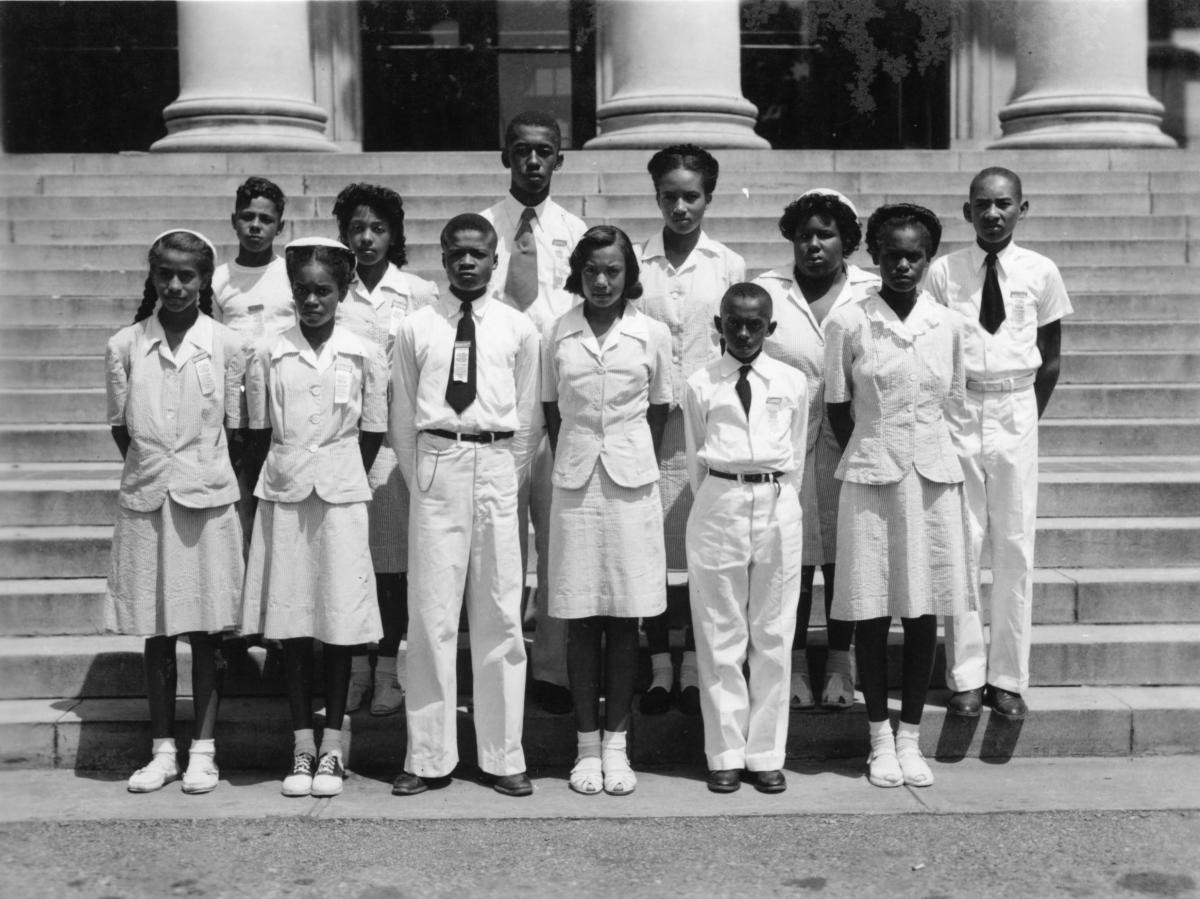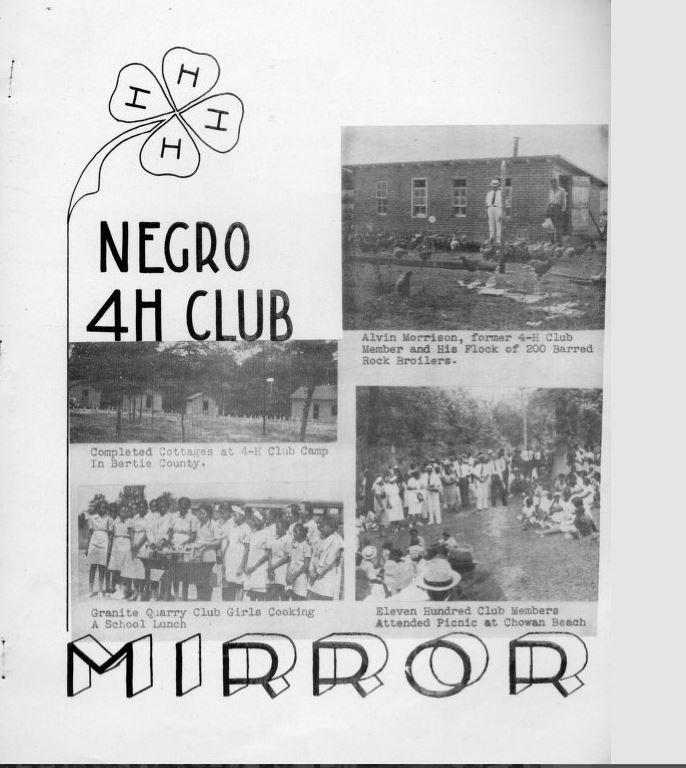4-H and Home Demonstration among African Americans: North Carolina's African American Extension Service
Originally published as "4-H and Home Demonstration among African Americans", Green 'N' Growing, The History of Home Demonstration and 4-H Youth Development in North Carolina, NCSU Libraries. Reprinted with permission.
 In 1911 North Carolina hired its first African American agricultural extension agent, Neil Alexander Bailey. Three years later 4-H Club work for African Americans in the state started when G. W. Herring organized a club in Sampson County.
In 1911 North Carolina hired its first African American agricultural extension agent, Neil Alexander Bailey. Three years later 4-H Club work for African Americans in the state started when G. W. Herring organized a club in Sampson County.
The first African American state club agent, John D. Wray, was hired in 1915 to coordinate African American club work across the state. In 1924 the first county camp and district Short Course were held for African American Club members. Beaufort County club boys and girls held a five-day countywide camp along the banks of the Pamlico River, and that same summer district Short Courses were held in Greensboro and Winton, North Carolina. In 1926 the first statewide Short Course was held in Greensboro at North Carolina Agricultural and Technical College. By 1936 African American membership reached 10,000 in the state. That year a loan fund was established for African American club members to borrow money to attend college, and the first full-time African American 4-H leader, R. E. Jones, was hired. In 1939 the program published the first statewide African American club newspaper, The Negro 4-H Mirror.
Growth continued during the 1940s and 1950s. In 1940 the first African American Wildlife Conservation Camp was held, and in 1942 the first African American district camp. Membership rose to almost 30,000 by 1946. By 1950 North Carolina had still not established any statewide camps for African Americans. The 4-H Club Foundation of North Carolina was formed to raise money for the establishment of such a camp, and in 1956 Camp J. W. Mitchell opened on Hammock's Beach in Onslow County. The 1950s also saw the first participation of African Americans in the International Farm Youth Exchange Program (IFYE) with a three month trip to England, Scotland, and Wales.
African American Home Demonstration work for women began in 1917. Prior to that the Smith-Lever Act of 1914 limited the funding sources for African American extension work, and it restricted the use of private funds, making it difficult to find alternative sources of funding. O.B. Martin of the United State Department of Agriculture and Nathan Carter Newbold, North Carolina's first agent of Negro Rural Schools, found a way to circumvent this. They paid the wages of teachers for two months during the summer using the Negro Rural Schools fund (administered by the General Education Board). This system allowed African Americans to establish a small number of clubs and classes similar to the gardening and canning clubs overseen by white agents.
In 1919 the Home Demonstration program hired forty-one African American emergency Home Demonstration agents. They assisted the white county agents during the canning season, and they were hired using funds from the federal World War I emergency appropriation. Among them was Dazelle Foster Lowe, who would play an important role in the development of Home Demonstration for African American women. In 1922 the first six African American full-time Home Demonstration agents were hired, including Sarah Williams of Beaufort County. The following year Lowe became a full-time Home Demonstration agent, and two years later she advanced to supervisor of all Negro home agents in the state. In 1935 Agricultural Extension hired Wilhelmina R. Laws to be the first state African American Home Demonstration specialist in the South. She had previously been an agent for six years in Mecklenburg County. It was not until 1940 that African American Home Demonstration clubs formed their own statewide organization, the State Federation of Negro Home Demonstration Clubs. In 1945 its name changed to the State Council of Negro Home Demonstration Clubs.
During the 1960s both 4-H and Home Demonstration/Home Economics in North Carolina integrated. With 4-H this officially occurred in 1965. In 1966 the State Council of Negro Home Demonstration Clubs merged with the North Carolina Organization of Home Demonstration Clubs to become the integrated North Carolina Extension Homemakers Association (later the North Carolina Extension Association of Family and Consumer Sciences).
References:
Carpenter, William L. and Dean W. Colvard. Knowledge is Power. Raleigh, NC: School of Agriculture and Life Science, North Carolina State University, 1987.
Clark, James W. Clover All Over: North Carolina 4-H in Action. Raleigh, NC: Office of 4-H and Youth, North Carolina State University, 1984.
Jones, Lu Ann. Mama Learned Us to Work: Farm Women in the New South. Chapel Hill, NC: University of North Carolina Press, 2002.
McKimmon, Jane Simpson. When We're Green We Grow. Chapel Hill, NC: University of North Carolina Press, 1945.
Reck, Franklin M. 4-H Story: A History of 4-H Club Work. Chicago: National Committee on Boys and Girls Work, 1951.
Wessel, Thomas, and Marilyn Wessel. 4-H: An American Idea 1900 - 1980. Maryland: National 4-H Council, 1982.
Additional Resources:
Jones, R. E. "1938 Annual Narrative Report of Negro 4-H Club Work." Greensboro, N.C.: A&T College. 1938. https://d.lib.ncsu.edu/collections/catalog/1938aa (accessed October 15, 2021).
North Carolina Extension Service Agricultural and Technical College. "A Description of Home Demonstration Work Among Negroes in North Carolina." November 1, 1956. https://d.lib.ncsu.edu/collections/catalog/gng00327 (accessed October 15, 2021).
Wray. J.D. "North Carolina Annual Report of J. D. Wray, Club Agent, for the year 1925." [1925]. https://d.lib.ncsu.edu/collections/catalog/1925aa (accessed February 19, 2016).
Images and publications from the Green 'N' Growing Collection, Rare & Unique Digital Collections, NCSU Libraries. https://d.lib.ncsu.edu/collections/catalog?_=1373555895868&f[ispartof_fa... (accessed February 19, 2016).
Image Credits:
"1946 Project Champions standing outside." Photograph. [1946]. Item 0012576, Green 'N' Growing Project, Special Collections Research Center at NCSU Libraries. https://d.lib.ncsu.edu/collections/catalog/0012576 (accessed October 14, 2021).
"Negro 4-H club mirror." Photograph. ca. 1939. Item gng00211, Green 'N' Growing Project, Rare & Unique Digital Collections, Special Collections Research Center, NCSU Libraries. https://d.lib.ncsu.edu/collections/catalog/gng00211 (accessed October 14, 2021).
18 February 2016 | Manor, Amy; Pronovost, Emily
